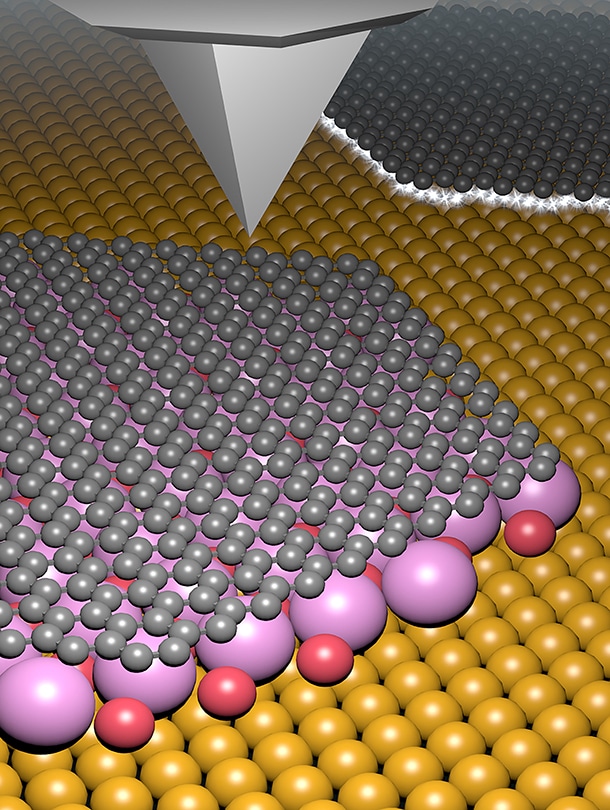Apr 30 2019
Using potassium bromide in the manufacture of graphene on a copper surface can give rise to improved outcomes.
 Potassium bromide molecules (pink) arrange themselves between the copper substrate (yellow) and the graphene layer (gray). This brings about electrical decoupling, as demonstrated by scanning probe microscopy studies. (Image credit: University of Basel, Department of Physics)
Potassium bromide molecules (pink) arrange themselves between the copper substrate (yellow) and the graphene layer (gray). This brings about electrical decoupling, as demonstrated by scanning probe microscopy studies. (Image credit: University of Basel, Department of Physics)
When potassium bromide molecules align themselves between copper and graphene, it leads to electronic decoupling. Physicists from the universities of Basel, Modena, and Munich have reported in the ACS Nano journal that this changes the electrical properties of the graphene produced, taking them closer to pure graphene.
Graphene comprises of a layer of carbon atoms with a thickness of just one atom arranged in a honeycomb pattern. It has been the focus of extensive international studies. Due to its high level of flexibility, together with exceptional electrical conductivity and stability, graphene has a number of potential applications, specifically in electronic components.
Molecules for Decoupling
Graphene is usually developed through a chemical reaction on metallic surfaces in a process called chemical vapor deposition. After that, the graphene layer and the metal underneath are coupled electrically, which weakens some of the unique electrical properties of graphene. In order to be used in electronics, the graphene must be shifted onto insulating substrates in a multistep process; during this process, it is prone to contamination and damage.
In order to achieve defect-free, pure graphene, it is thus better to decouple the graphene electrically from the metallic substrate and to devise a technique that enables easier transfer with no damage. The team headed by Professor Ernst Meyer from the Department of Physics and the Swiss Nanoscience Institute (SNI) of the University of Basel is finding methods of integrating molecules between the graphene layer and the substrate after the chemical deposition process, which results in this type of decoupling.
Altering Electrical Properties
In a research conducted by SNI doctoral student Mathias Schulzendorf, researchers have demonstrated that potassium bromide is well suited for this. Potassium bromide, a soluble hydrogen bromide salt, is different from the chemically similar compound sodium chloride, in that its molecules align themselves between the graphene layer and the copper substrate. This was shown by scientists in a range of scanning probe microscopy studies.
Calculations carried out by colleagues at the University of Modena and Reggio Emilia (Italy) describes this phenomenon: It is more energetically beneficial for the system if potassium bromide molecules align themselves between the graphene and copper than if they are applied on the graphene—as it takes place with sodium chloride.
The scientists have demonstrated that the intermediate layer of potassium bromide changes the electrical properties of graphene—until they relate to those usual for free graphene.
Our work has demonstrated that the graphene and the underlying metal can be decoupled using potassium bromide, bringing us a key step closer to producing clean and defect-free graphene.
Dr Thilo Glatzel, Project Supervisor and Member of Meyer’s Team.